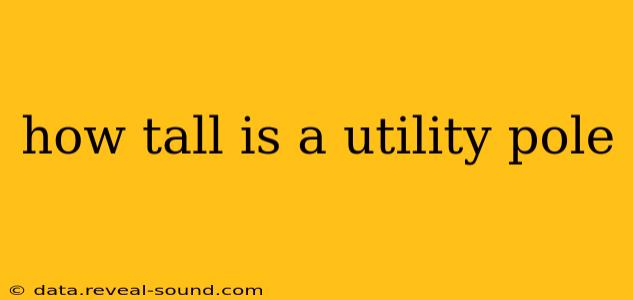How Tall is a Utility Pole? Understanding the Variables
The height of a utility pole isn't a one-size-fits-all answer. Several factors influence how tall these essential structures need to be, resulting in a range of heights rather than a single definitive measurement. Let's explore the key variables and typical heights you might encounter.
What determines the height of a utility pole?
The height of a utility pole is primarily determined by:
- Voltage: Higher voltage power lines require taller poles for safety and clearance. Higher voltage means greater potential danger, necessitating increased distance from the ground.
- Terrain: Poles in hilly or mountainous areas often need to be taller to maintain consistent line clearance. The terrain dictates the effective height of the line above the ground, even if the pole itself is the same height.
- Location: Urban areas might have shorter poles due to building heights and density, while rural areas may necessitate taller poles for broader coverage and clearance.
- Type of Line: Distribution lines, which supply power to homes and businesses, are typically shorter than transmission lines, which carry power over long distances at high voltages. Transmission lines, carrying significantly higher voltage, require greater clearances.
- Number of Lines: Poles carrying multiple lines of different voltages might be taller to accommodate all lines with necessary clearances.
What are the typical heights of utility poles?
While there's no universal standard, utility poles commonly range from 30 to 55 feet (9 to 17 meters) in height. You'll find:
- Shorter poles (30-40 feet): These are often used for distribution lines in urban areas or for lower voltage applications.
- Taller poles (45-55 feet): These are more common for transmission lines, higher voltage distribution lines, or in areas requiring greater clearance due to terrain or other factors.
Keep in mind that these are just general ranges. Specific pole heights are determined on a case-by-case basis by engineers and utility companies, considering all the factors mentioned above.
Are there different types of utility poles?
Yes, utility poles aren't all created equal. They come in various materials, including:
- Wood: Still the most common material, offering a good balance of strength, durability, and cost-effectiveness.
- Steel: Used in situations requiring higher strength or resistance to specific environmental conditions.
- Concrete: Less common but used in specific applications where durability and resistance to certain factors are paramount.
The material choice can influence the design and ultimately the overall height of the pole.
How are utility pole heights measured?
The height of a utility pole is typically measured from the ground to the top of the pole itself. This doesn't include any additional structures or equipment mounted on top, such as transformers or insulators. The measurement is crucial for ensuring safe clearances and proper line maintenance.
Why are some utility poles taller than others?
As discussed earlier, the height variation reflects the numerous factors influencing pole design and installation. The primary consideration is maintaining sufficient clearance to prevent accidental contact and ensuring reliable power delivery, no matter the conditions.
This information provides a comprehensive understanding of the factors influencing utility pole height and offers insights beyond a simple numerical answer. The variability ensures safe and efficient power delivery across diverse environments.
